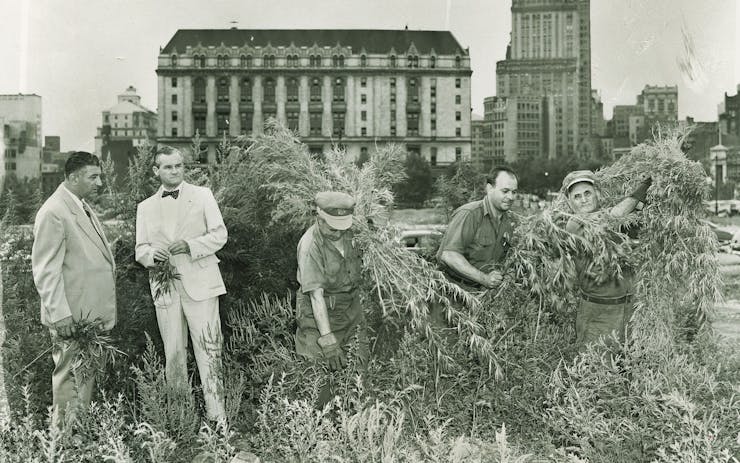In the early days, cannabis and hemp grew wild in North America after being imported by colonizers. Before the 1930s, seeing a field of six-foot cannabis plants in an abandoned yard wasn’t uncommon, even in crowded New York City. But 60-odd years ago, weed ended up hidden from public view almost entirely.
Not long after the very first mention of cannabis in the Brooklyn Daily Eagle on—wait for it—April 20th, 1924, the city began to address its wild cannabis problem with a little help from the Sanitation Department. An old school slash-and-burn effort sought to get rid of it on the mean streets of NY. And yes they called it “loco weed.”
When some see a cannabis leaf, real, cartoon, imagined, or otherwise, they recoil as if presented with a skull and crossbones or something terribly poisonous. This reaction is the conditioning of decades of drug education which have demonized the plant. Headlines like “Some Nice Ladies Discover Marijuana” and “Robt. Mitchum Held With Pal, 2 Girls at Movie Reefer Party” were common in the 1940s, showing that it was a commonly used intoxicant, much like today.
Understanding why the plant left our consciousness and entered the counterculture is critical. The disappearance of cannabis and feral hemp from our byways, abandoned lots, commodity supply, and pharmacological tool kit has helped fuel a disconnect with the plant.
The White Wings

Weeding out operation–Police Inspector Peter Terranova, commanding officer of the narcotics squad, flanked by Anthony Cristiano, a Department of Sanitation workman, and Frank Creta, general inspector of the department, exhibit part of a haul of more than 100 pounds of marijuana found growing at 82 Butler St. The dope weed was burned in department incinerators. (Brooklyn Public Library)
In 1950s New York, the Department of Sanitation was helping to fuel that disconnect. NPR called it a “historic removal effort” in a 2014 article, saying:
“Weed grew everywhere, with seven-foot high plants sprouting in fields from Williamsburg to Cobble Hill to East New York. In 1951 alone, a division of the Department of Sanitation called the ‘White Wing Squad’ confiscated and destroyed 41,000 pounds of the plant.”
This war on open-air cannabis in Brooklyn was first mentioned in The Brooklyn Daily Eagle on June 20th, 1951 with a photo and caption of the deed: “EVIL HARVEST—Sanitation workers launch war of eradication on lush crop of marijuana growing in city’s vacant lots.” And for a bit of super-potent historical context, the headline under it touts a rounding up of communists by the FBI.
Later that year, the White Wing squad was finally mentioned by name, reportedly taking three to four days to destroy the “biggest crop yet” in world famous Coney Island, where Sanitation Inspector John E. Gleason notes plants “the size of Christmas trees.” Clearly no Santa’s helper, Gleason is even reported helping the Narcotics Division discern who may have planted the field.
Having felt satisfied with their program, it seems that after the ‘50s, cannabis enforcement fell primarily to the New York Police Department.
Who were they so afraid of?
After World War II’s brief reprieve of cannabis hysteria, it picked right back up with a renewed fervor. Chasing once again after jazz musicians and urban black folks, new targets were sought beginning in the 1950s, namely immigrants from the Caribbean, leftists—including but not limited to socialists and communists—and the emerging literary movement of the time, the Beat poets.
Shop highly rated dispensaries near you
Showing you dispensaries nearThe culture of the era was based on the prosperity of the post-war society, and the triumph of capitalism and middle-class values were cemented. Madison Avenue may have had the Mad Men during this time, but Greenwich Village and the Lower East Side had Ginsberg, Kerouac, and Burroughs.
Writer Anthony Gramuglia sums up the connection quite well:
“Society’s treatment of marijuana led to it becoming a taboo, which led to similarly taboo jazz music to embrace it. In turn, the counter-culture embraced both jazz and marijuana as pillars to its anti-establishment movement. And so on, appropriating other literature and mindsets to further expand their objectives.”
New York City was always a hub of counterculture, and as long as it has welcomed waves of new residents and new ideas, nativism has reared its ugly head in ugly ways. We’ll never know how far the ripple effects of the campaign to cut cannabis out of New York spread, but it coincided with waves of enforcement targeted first at Mexican immigrants in the 1930s, communist, leftist, and civil rights groups in the 1950s, and well into the 1970s.
No matter the intent of the Sanitation Department or the NYPD on giving weed the boot from the five boroughs, it’s impact is a legacy that has continuously disadvantaged communities, resulting in consistent inequality, as well as a huge discrepancy in who is making money in today’s legal cannabis market.





